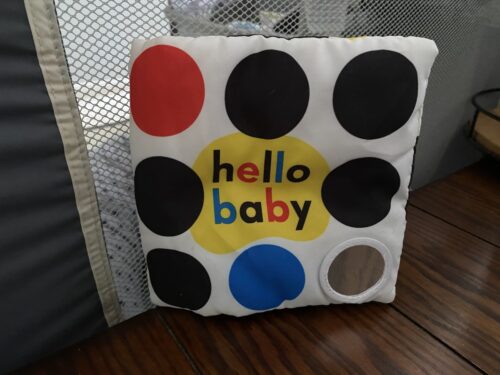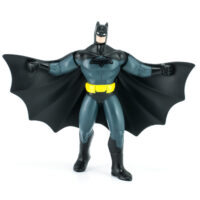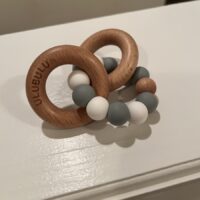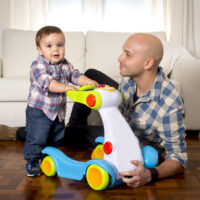Learning to point is a major communication milestone for your baby. While your baby won’t start pointing until they are developmentally ready, there are a lot of strategies on how to teach baby to point. We’ll take a look at them below.
Communication Gestures
Even though your baby might not yet have the motor skills needed to make gestures, they’re still taking in all that is happening around them.
Something that helps is making your faces and movements animated when interacting with your baby. Point to things and label them as you explain what you are doing. For example, you might point to your baby’s shirt and say “shirt” before putting it on them. Use your index finger to point out the neighbor’s dog or to gesture to different fruits at the grocery store.
Blow Bubbles
Even though my boys are 5 and 7 now, they still love chasing bubbles through the yard. When they find them, it’s only natural that they want to point to and pop the bubbles. The more bubbles the better – they love popping bubbles as fast as they can.
Babies are generally fascinated with bubbles too, and even more, fascinated when they can reach out and pop them. While your child might not relate what they are doing with pointing right away, popping bubbles practices the finger movements needed to point at something. It’s also a great way to practice cause and effect.
RELATED: The Best Outdoor Toys for Toddlers
Toys That Encourage Motor Development
Your baby has a lot to discover after being born. Once they start to realize their hands and fingers are attached, they start to use them to entertain themselves. They may wiggle them, chew on them, or use them to grasp their favorite toys. As they do these things, your baby is exercising their finger muscles and building on the skill that they will eventually use to gesture through waving, clapping, and pointing.
Of course, there are plenty of newborn toys that encourage motor development and other learning. The best thing you can do is choose a variety of toys that encourage different types of movement to play. From musical toys for playtime to bath time toys that encourage learning, there are plenty of ways to get your little one using their fingers.
RELATED: How to Teach Baby to Clap
Tummy Time
Tummy time is one of the first exercises that you’ll want to do with your baby. Spending time on your baby’s tummy will help them develop muscles in their neck, shoulder, and back. These muscles are critical for your little one learning to hold their own head up and then later as they begin to crawl. Tummy time is also important for motor development, which makes it the perfect time to teach your baby other skills as well.
On average, your baby should be doing an hour of tummy time each day by the time they are three months old. Lay down in front of your baby so they can see what you are doing and use your fingers to ‘rake’ across the carpet or the blanket in front of you. This lets your baby get used to using their fingers to explore the world around them.
Once your baby is lifting their head and neck on their own, you can also put toys in front of him or her. They may reach toward these toys to indicate their interest, especially if your baby isn’t crawling yet on their own.
RELATED: Best Baby Play Mats and Gyms
Offer Your Baby Choices
Even if your baby doesn’t have the fine motor movement needed to isolate their index finger and point, they learn to gesture toward what they want when you give them choices. You can offer your baby choices between two foods at snack time or between two toys at playtime. This gives your little one the option to voice their opinion about something, which encourages them to point when communicating once they develop the skill.
RELATED: The Best First Foods For Your Baby
Exercise Your Baby’s Hands and Fingers
Playing hand games like patty cake is a great way to develop fine motor skills and move your baby’s hands and fingers. Even if your baby isn’t clapping on their own, you can enlist the help of someone else to sit behind baby and help them with the hand movements. Itsy Bitsy Spider is another fun one that helps children develop the hand-eye coordination needed to point.

Help Baby Point
In addition to doing fun songs and playing games with your child, you can physically help your baby point. Hold their fingers down as you gently extend their pointer finger forward. Then, help them point to different things as you give them a name. By exercising your child’s finger in this way, you’re teaching them how to point and giving them an introduction to how to use these different muscles in their hands.
Hand Over Hand Guidance
Another great technique, especially for babies that aren’t pointing yet, is hand-over-hand guidance. You may notice sometimes that your baby is interested in something that they can’t reach. Your baby may not yet be ready to point, even with their entire hand or arm. What you can do is hold their hand in yours as you gesture toward that item and tell them what it is.
If your baby pulls away or seems uncomfortable, try again at a different time. You don’t want to make them associate any unpleasant feelings with pointing at different objects. If your baby seems excited, however, you can smile and use this practice regularly.
Encourage Pushing Buttons
Pushing buttons is a great way to get your little one using their index finger. Some toys for toddlers have buttons that make noises or cause the toy to light up. As you encourage your baby to push buttons, they’re using the same finger that they will when they point later on.
Point During Story Time
Something else you can do is point to words and pictures during storytime. Using your finger to help your child follow along with the story is a great way to encourage learning. Additionally, you can help them identify different things in the picture, which helps them understand what is happening and what the words from the story mean.
Of course, you can also pick books that encourage your child to interact with them. This might include actions like opening doors, pushing buttons, and more. One particularly helpful book series for pointing is the Melissa & Doug Poke-a-Dot books.Melissa & Doug Poke-a-Dot books. These encourage your child to poke different dots as the story goes on, letting them easily learn early counting, too. The buttons make a popping or clicking sound when pressed. They have cute books in this line like Old McDonald’s Farm, A-to-Z dinosaurs, first words, favorite colors, and more.
Engage in Sensory Play
Sensory play develops more than just the big five senses. It gives your child a chance to explore the world around them and all the different textures they might experience. There are a lot of ways to let your baby engage in sensory play. For example, you might take them to the beach and let them play in the sand or have them finger paint something. Your baby can even play with cheerios or yogurt if you’re worried about them putting things in their mouth.
RELATED: The Best Baby Safe Paint Products
Positive Reinforcement
As your baby starts gesturing toward things and trying to communicate with you, it’s important that you get excited about their success. Clap, put on a big smile, and talk in an excited voice as you tell your baby how good they are doing and how excited you are that he or she can point.
FAQs – How to Teach Baby to Point
When do babies start pointing?
Some babies start early pointing as early as six months of age, usually using their entire arm to gesture toward something instead of just their index finger. However, it usually isn’t until between 9-14 months of age that your baby starts pointing using their index finger. Some babies do start to follow a point earlier than this though, around age 4-6 months.
It’s okay if this skill takes a little longer to develop, especially since babies develop at a unique rate. You may want to talk to your pediatrician if this skill doesn’t show itself by 18 months of age, or if your baby isn’t communicating in other ways.
Is it important for my baby to point?
Pointing is a major milestone for non-verbal communication. It is one way that your baby expresses what they want or what is holding their interest at the moment. Additionally, as you respond to your baby and talk to them about what they are pointing at, they are soaking in early language. One study even showed that gestures such as pointing could predict a speech delay. Children who pointed with their entire hand at 12 months were likely to have a speech delay by 24 months, compared to children who pointed using just their index finger.
Even though pointing seems simple, it actually expresses a complex pattern of thoughts. It is believed that babies who can point have developed an awareness of object permanence. For example, when they point to a toy that is no longer in sight they are remembering where the toy was sitting.
What other gestures should my baby know?
Babies start to develop the ability to perform non-verbal gestures around age 6-7 months. In most cases, your child will start waving first. Then, they’ll develop the ability to clap by around 9 months and the ability to point not long after that.
Final Word
Pointing is just one of the many ways your baby will try to communicate with you in their first year of life. It helps them express interest, as well as their wants and needs. For parents wondering how to teach baby to point, the strategies above should pave the way for your baby to learn. They’ll be pointing at things before you know it!






